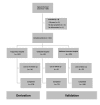Derivation and validation of a clinical prediction rule for sleep apnoea syndrome for use in primary care
- PMID: 30564714
- PMCID: PMC6184092
- DOI: 10.3399/bjgpopen18X101481
Derivation and validation of a clinical prediction rule for sleep apnoea syndrome for use in primary care
Abstract
Background: Several clinical prediction rules (CPRs) are available for sleep apnoea-hypopnoea syndrome (OSAH), but they are difficult to apply in primary care (PC).
Aim: Derivation and validation of a CPR using simple measurements available in PC.
Design & setting: A prospective study conducted in health centres from the area of influence of three Spanish hospitals.
Method: Patients (aged 18-70 years) who attended for any reason; who presented with at least one of the three key symptoms for OSAH (snoring, breathing pauses while sleeping, and daytime sleepiness); and who were not undergoing non-invasive ventilation or prior treatment with continuous positive airway pressure (CPAP) were included. Anthropometric data, smoking habit, comorbidities, and Epworth test were collected. Patients were subsequently referred to the sleep unit (SU), where the decision was taken whether or not to instigate treatment. A multivariate logistic model was constructed using a sub-sample and scores assigned based on the regression coefficients; the CPR was validated with the remaining sample. Both receiver operating characteristic (ROC) curves were plotted and the sensitivity, specificity, and predictive values calculated.
Results: The derivation sample comprised 352 patients, with 260 in the validation sample. The final factors (arterial hypertension [AHT], age, body mass index [BMI], and sex) were used to develop a rule with scores ranging from 0.00-5.50. The cut-off point that optimises the area under the curve (AUC) is ≥2.50 points (AUC = 0.78; sensitivity = 86%; specificity = 54%; positive predictive value [PPV] = 45%; negative predictive value [NPV] = 90%; likelihood ratio [LR] = 0.26). The properties for the validation sample with this cut-off point are as follows: AUC = 0.68; sensitivity = 81%; specificity = 43%; PPV = 61%; NPV = 68%; LR = 0.44.
Conclusion: As in similar cases, the specificity is low, meaning that healthy people are referred to a specialist. A negative result rules out the disease in most cases.
Keywords: clinical predictive rule; primary health care; sleep apnea.
Figures
References
LinkOut - more resources
Full Text Sources
Research Materials


